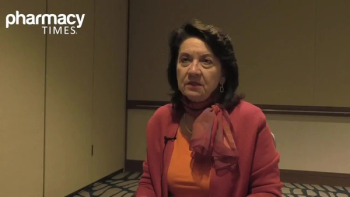
Pharmacy Leaders Eye Opportunities, Challenges for Legislation in the Year Ahead
Key Takeaways
- ASHP is engaging with Congress in a bipartisan manner to address health-system pharmacy issues amid a polarized political environment.
- Scope expansion and pharmacist reimbursement are progressing, with many states allowing pharmacists to prescribe medications and enroll as providers.
The progress made in areas like scope expansion and reimbursement is encouraging, suggesting a growing recognition of pharmacists’ value within the health care system.
Leaders from the American Society of Health-System Pharmacists (ASHP) discussed legislative priorities and anticipated challenges during a session at the ASHP 2024 Midyear Clinical Meeting, happening in New Orleans, Louisiana.
“The main thing that I want to communicate to you [is that] obviously we are in a polarized political environment,” said Tom Kraus, JD, vice president of government relations at ASHP. “ASHP is going to engage with top members of Congress in a bipartisan manner and with the new administration.”1
The political climate is rapidly changing, and many questions still remain, particularly as the Trump administration continues to take shape. Frank Kolb, JD, MPh, federal legislative affairs director with ASHP, said he expects lots of discussion around spending in the coming year. The small margins for Republicans in both the House and Senate will require bipartisan support, which Kraus noted is already present for many issues important to health-system pharmacies.1
“A lot of the topics that we engage on have bipartisan support,” Kraus said. “You have to change the way that you engage and what’s a priority, but most of these issues have bipartisan support, so we are not necessarily changing our ask because of the shift in Congress.”1
Scope expansion has steadily continued, with 30 states now permitting pharmacists to prescribe at least 1 medication. Kraus noted that states are really driving this change, which then puts pressure on Medicaid to do the same.1
Pharmacist payment has also steadily expanded, with Medicaid plans in 30 states allowing pharmacists to enroll as an individual provider. Furthermore, 17 states require Medicaid reimbursement of all or nearly all services within pharmacist scope, and 9 states require both Medicaid and commercial plans to reimburse pharmacists for any covered service within their scope.1
“If there’s 1 thing that you take away, take that…there’s progress year over year, and I think we should all be excited about that,” Kraus said.1
Standard of Care
Kyle Robb, PharmD, director of state policy and advocacy at ASHP, said there is an emerging shift toward a standard of care regulatory model, under which the “practice of pharmacy” has a broad definition. Other key elements of this approach include elasticity to accommodate future scope expansion; elimination of prescriptive regulations wherever possible; and establishment of accountability mechanisms and aligned oversight functions.1
“There’s been a big push to reframe the way that we approach regulation in the practice of pharmacy,” Robb said. “It really boils down to flipping that script, saying that individual practitioners that can justify that they have the training, education, and qualifications, if they are able to provide these services at a level of care comparable to any other practitioner, that they can provide these services.”1
Iowa has been at the forefront of this model in its state legislation, and ASHP has worked to provide model legislation for other states. For instance, ASHP has model legislation to help states expand access to reproductive and sexual health services, saying that pharmacist training and education aligns with these goals.1,2
States are also expanding pharmacists’ scope in the management of opioid use disorder (OUD) and the ability to provide treatments. ASHP’s model legislation on this issue does not suggest that pharmacists can solely manage OUD, but rather utilizes pharmacists as a safety net to improve access and ensure that patients do not drop out of OUD management systems.3
“Since 2023, we’ve seen a number of states pass legislation specifically authorizing this,” Robb said. “Nevada, Colorado, Oregon, and Iowa within the last 2 years have specifically passed legislation that authorizes pharmacists to engage in this.”1
340B Drug Pricing Program
One area that has seen greater challenges is the 340 Drug Pricing Program, which Kraus said has seen “erosion.”1
“This and site-neutral payments are the 2 areas where we really need to be sounding the alarm to our institutions…and making sure they really understand the financial risks,” Kraus said. “This is not just about pharmacy but really about financial risks to these institutions.”1
Manufacturers are limiting access to drugs and discounts through contract pharmacy, conditioning discounts on claims submission to databases, and threatening conversion to a rebate model, all of which threaten the program. Jillanne Schulte Wall, JD, senior director of health and regulatory policy at ASHP, noted that Johnson & Johnson threatened to go to a rebate model for 2 drugs, but the Health Resources and Services Administration (HRSA) threatened to cut them off from Medicaid.4 This approach could be effective with other manufacturers, as well.1
ASHP is pushing the US Department of Health and Human Services (HHS) to take action against manufacturers who fail to comply with the 340B program, and there is ongoing litigation with HRSA and manufacturers over contract pharmacy restrictions.1
Site-Neutral Payment
Site-neutral payment could be one particular area of challenge amid changing dynamics in Washington, DC. Kraus noted that site-neutral payment constitutes several billion dollars that Congress could shift to other issues, so pharmacists and other stakeholders need to illustrate that this would have negative impacts on patient care and health systems overall.1
“The simple premise of site-neutral payments…is basically they would readjust payments to different hospital departments for many different services,” Kraus explained. “The premise is that these are equivalent services, so regardless of service you should pay them the same. So, what we’re trying to say is no, these are not equivalent services, and here’s why.”1
The heightened costs for hospital-provided services encompass all of the unique requirements for that environment, such as cleanrooms, on-call providers, and on-site pharmacies. One ASHP member survey found that site-neutral payment cuts and 340B program changes would threaten the financial health of their hospital, force facility closures, and result in cutting patient services.1
Pharmacy Benefit Manager (PBM) Reform
PBM reform has been top-of-mind in recent years, and that shows no signs of changing. Robb said the biggest development over the past year has been the report from the Federal Trade Commission (FTC), which alleged anticompetitive practices. Kraus said it remains to be seen, however, how the Trump administration will handle this ongoing investigation and report.1 One hopeful sign, however, is that PBM reform in the states has been largely bipartisan.
Key conclusions in the FTC report were that leading PBMs can exercise significant influence over patients’ access to drugs and the costs; vertically integrated PBMs prefer their own affiliated businesses, disadvantaging others; PBMs use their market power to impose contractual disadvantages; and PBMs and brand drug manufacturers negotiate rebates that are expressly conditioned on limiting access to lower-cost alternatives.5
This report was quickly followed by a lawsuit against Caremark, Express Scripts, and Optum, alleging that they conspired to inflate list prices of insulins. Kraus noted that the FTC has not sued manufacturers, but did acknowledge concerning conduct.1
Congress has considered various approaches to PBM reforms, including the following1:
- Prohibiting spread pricing in Medicaid and group plans
- Reporting rebates, fees, and alternative discounts received by PBMs
- Limiting network pharmacy performance fees
- Reporting relationships between PBMs and affiliated entities
- Requiring rebates and other remuneration be passed through to the sponsor
As of now, Kraus noted that the House-passed bill for PBM reform also includes site neutrality. He said this is a “deal-breaker” for ASHP’s support.1
Medication Shortages
Finally, the panelists discussed legislative efforts to manage and reduce medication shortages. This is another area with bipartisan interest, given the nearly 300 active drug shortages.6 An ASHP survey found that more than half of hospitals have been forced to ration, delay, or cancel treatments or use alternate therapies as a result of shortages.7
“We had legislation a couple years back that gave us more transparency into things like contract manufacturing…and we saw a really good response during this last round of shortages after the hurricanes with Baxter,” Wall said.1
Wall was referring to shortages of intravenous fluids after Baxter’s manufacturing facility in North Carolina was damaged by Hurricane Helene.8 She said Baxter took immediate action and communicated proactively, although she added that HHS’s communication was a little slow.
“Some of the lower-hanging fruit for shortages has already been addressed, so now we are working with this sort of loose-knit coalition to come to the root causes and some solutions,” Wall said.1
Conclusion
The progress made in areas like scope expansion and reimbursement is encouraging, suggesting a growing recognition of pharmacists’ value within the health care system. Similarly, the emerging shift toward a standard of care regulatory model holds significant promise for the future of pharmacy practice. By focusing on patient care outcomes and allowing qualified pharmacists to practice to the full extent of their training, this approach can improve access to care and enhance patient safety.
However, navigating the current political climate and ensuring continued support for these initiatives will require ongoing advocacy and collaboration. Kraus encouraged attendees to get involved with pharmacy organizations and advocate for the profession, reaching out to their representatives to provide their crucial perspective.
REFERENCES
1. Kraus T, Wall JS, Kolb F, Robb K, Dopp AL. Engaging Federal and State Policymakers: Key Issues for Health-System Pharmacy 2025. Presented at: American Society of Health-System Pharmacists 2024 Midyear Clinical Meeting. New Orleans, LA. December 10, 2024.
2. Model State Law to Improve Access to Sexual and Reproductive Health Services from Pharmacists. ASHP. Accessed December 10, 2024. https://www.ashp.org/-/media/assets/advocacy-issues/docs/Sexual-and-Reproductive-Health/ASHP-SRH-Model-State-Legislation.pdf
3. Model State Law to Improve Access to Medications for Opioid Use Disorder from Pharmacists. ASHP. Accessed December 10, 2024. https://www.ashp.org/advocacy-and-issues/key-issues/opioids/model-moud-prescribing-legislation?loginreturnUrl=SSOCheckOnly
4. HRSA to J&J: Cease implementation of proposed 340B rebate model. American Hospital Association. September 17, 2024. Accessed December 10, 2024. https://www.aha.org/news/headline/2024-09-17-hrsa-jj-cease-implementation-proposed-340b-rebate-model
5. Pharmacy Benefit Managers: The Powerful Middlemen Inflating Drug Costs and Squeezing Main Street Pharmacies. Federal Trade Commission. July 2024. Accessed December 10, 2024. https://www.ftc.gov/reports/pharmacy-benefit-managers-report
6. National Drug Shortages, January 2001-September 2024. ASHP. 2024. Accessed December 10, 2024. https://www.ashp.org/-/media/assets/drug-shortages/docs/2024/2024-Drug-Shortages-Survey.pdf
7. Severity and Impact of Current Drug Shortages. ASHP. June/July 2023. Accessed December 10, 2024. https://www.ashp.org/-/media/assets/drug-shortages/docs/ASHP-2023-Drug-Shortages-Survey-Report.pdf
8. Hurricane Helene: Baxter’s manufacturing recovery in North Carolina. FDA. Updated December 6, 2024. Accessed December 10, 2024. https://www.fda.gov/drugs/updates-2024-hurricane-season/hurricane-helene-baxters-manufacturing-recovery-north-carolina
Newsletter
Stay informed on drug updates, treatment guidelines, and pharmacy practice trends—subscribe to Pharmacy Times for weekly clinical insights.

















































































































































































































